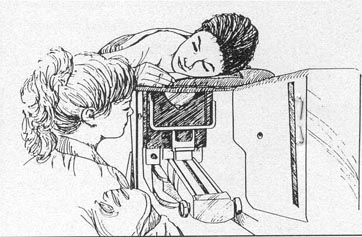Info about the Mammotest® Biopsy Procedure
(The following is from the brochure provided as an educational service by Fischer Imaging Corporation, (c) 1998 Fischer Imaging Corporation -- with a little humor thrown in by me with an extra graphic!)
"Why do I need a Mammotest® biopsy?"
Probably by now your physician has explained to you that your mammogram has revealed an abnormality in your breast. In the past, these abnormalities, or lesions, were treated in one of two ways. Either they were "followed" over a period of time by the physician to see if there was a significant change, or the patient had surgery to remove the lesion completely (surgical excisional biopsy). However, a large percentage (about 80%) of these abnormalities are benign and present no health risk to the patient. For this reason, the technology of stereotactic breast biopsy was developed. Physicians agree that the Mammotest biopsy is a less painful, less invasive way to obtain the tissue sample needed for diagnosis. This procedure requires much less recovery time than does an excisional biopsy, and there is no significant scarring to the breast.
"How is the Mammotest® biopsy performed?"
The Mammotest procedure will be performed by a physician with help from a radiologic (x-ray) technologist. Before you arrive, the physician will have studied your mammogram to become familiar with the location of the abnormality.
After checking in, you will be asked to change into a hospital gown and escorted to the biopsy room. The technologist will ask you to lie face down on the special Mammotest examination table, making sure you are as comfortable as possible. Your breast will be positioned through a special round opening in the table. The table will then be elevated so the physician and technologist can work from below.
The first part of the procedure will seem much like your mammogram, except that you are lying down instead of standing up. Your breast will be compressed with a compression paddle, just as it was during your mammogram. A confirming x-ray will be taken to ensure that the area of the breast containing the lesion is correctly centered in the paddle window. When the position is confirmed, two stereo x-rays will be taken. They are called stereo images because they are images of the same area from different angles. With the help of a computer, the exact positioning of the biopsy needle is determined from these stereo images.
Using this information, the physician will then position the device which holds the biopsy needle for the correct angle of entry. Next, the physician will numb the biopsy area by injecting a local anesthetic into your breast. This will be done with a very tiny needle and you may feet a slight sting in your breast at the injection site.
After the local anesthetic has taken effect, the physician will insert the biopsy needle into your breast. Another set of stereo x-rays will then be taken to ensure proper needle placement. Once placement is con- firmed, the physician will tell you to hold very still while the tissue samples are acquired. When the physician has retrieved all the samples, the compression paddle will be released from your breast. The nurse or technologist will then apply pressure to the biopsy site for five to ten minutes to prevent bleeding. Afterwards, a dressing will be applied which you will wear home. You will then be given some post-procedure care instructions.
"Will it hurt?"
Because the physician uses a local anesthetic, there is only a small amount of pain during the procedure. However as individuals, each of us has a slightly different pain threshold. Most patients occasionally report that they feel pressure or a slight discomfort in the biopsied area, as the procedure is being done.
"Will I be able to resume my normal activities right away?"
After the technologist or nurse has applied a dressing to the biopsy site, you may get dressed. Most women feel fine after the procedure and return to their normal routine right away. However, we recommend that strenuous exercise or activity be avoided for at least 24 hours. If possible, it's not a bad idea to go home after the procedure, put your feet up, and simply relax.
"What instructions should I follow after the biopsy?"
The physician performing the biopsy will give you instructions for your biopsy aftercare. These instructions will be specific to your individual case.
"When can I expect the results of my biopsy?"
The physician performing the biopsy will send the tissue sample to a pathologist who will look at it under a microscope. The pathologist will examine the tissue and send a report to the referring physician within a few days. Your referring physician will contact you to discuss your results.



